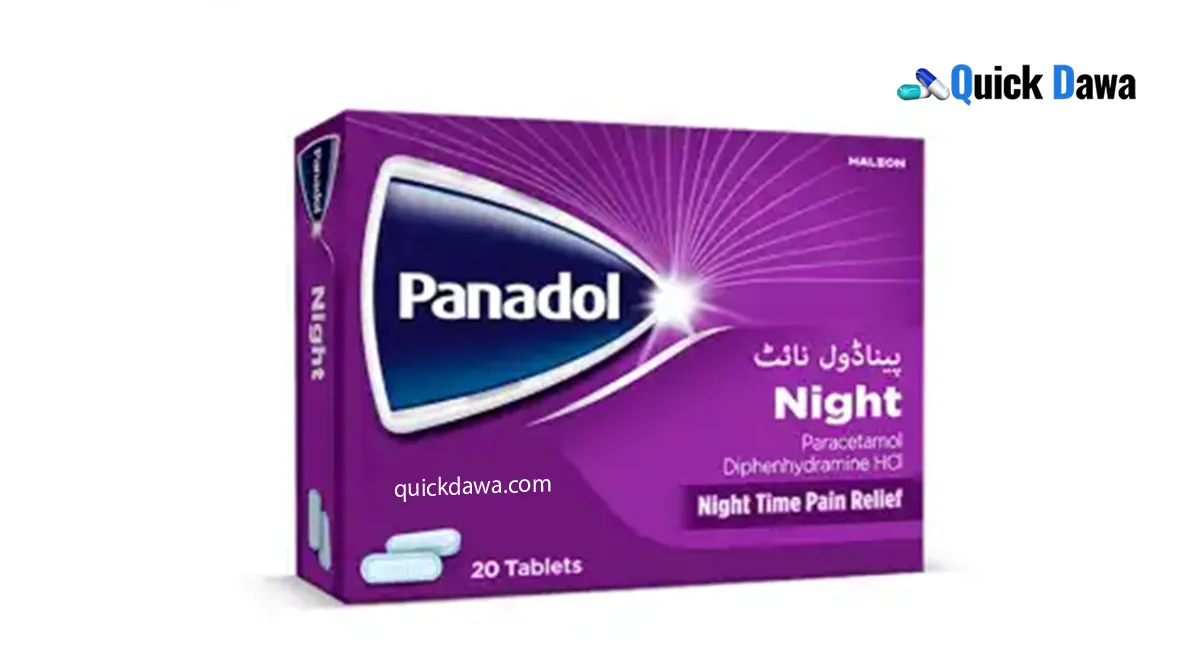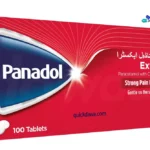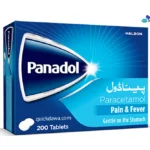Panadol Night is a combination medication containing paracetamol and diphenhydramine hydrochloride.
- Paracetamol is a pain reliever and fever reducer.
- Diphenhydramine hydrochloride is an antihistamine that can cause drowsiness and help you sleep.
Panadol Night is used to provide temporary relief of pain when associated with sleeping difficulty, such as headache, migraine, backache, arthritis, rheumatic and muscle pain, neuralgia, toothache, or period pain.
Important considerations:
- Consult a doctor or pharmacist before taking Panadol Night, especially if you are pregnant, breastfeeding, taking other medications, or have any underlying health conditions.
- Do not exceed the recommended dose.
- Do not take this tablet for more than 7 consecutive nights without consulting your doctor.
- Avoid alcohol while taking Panadol Night as it can increase drowsiness.
- Be aware of potential side effects such as drowsiness, dizziness, dry mouth, and blurred vision.
Panadol Night Tablets Uses
- Pain relief: Panadol Night is used to relieve various types of pain, including headaches, backaches, muscle aches, toothaches, and menstrual cramps.
- Sleep aid: The diphenhydramine in this tablet can help you fall asleep if you are having trouble sleeping due to pain.
Panadol Night Tablets Side Effects
Panadol Night can cause a number of side effects, including:
- Drowsiness: This is the most common side effect of diphenhydramine.
- Dry mouth
- Constipation
- Blurred vision
- Dizziness
- Nausea
- Vomiting
- Headache
- Restlessness
- Difficulty urinating
In rare cases, Panadol Night can cause more serious side effects, such as:
- Liver damage
- Allergic reactions
- Seizures
Warnings
- Panadol Night should not be taken by children under the age of 12.
- You should not take this tablet if you are allergic to paracetamol or diphenhydramine.
- You should not take this tablet if you are taking other medications that contain paracetamol or diphenhydramine.
- You should not take this tablet if you have certain medical conditions, such as liver disease, kidney disease, glaucoma, or an enlarged prostate.
- You should not drink alcohol while taking this tablet.
Overdose
Taking too much Panadol Night can cause serious health problems, including liver damage and death. If you think you have taken too much this tablet, seek medical attention immediately.
Panadol Night Tablets Price
1 Strip = 10 Tablets
Per Strip = Rs. 109.40
FAQs
What is Panadol Night?
It is a combination medication containing paracetamol and diphenhydramine hydrochloride. It is used to provide temporary relief of pain when associated with sleeping difficulty.
What are the active ingredients in Panadol Night?
- Paracetamol: A pain reliever and fever reducer.
- Diphenhydramine hydrochloride: An antihistamine that can cause drowsiness and help you sleep.
How does Panadol Night work?
Paracetamol works by blocking pain signals in the brain, while diphenhydramine hydrochloride helps to relieve pain and promote sleep by blocking histamine receptors in the brain.
What are the side effects of Panadol Night?
Common side effects include drowsiness, dizziness, dry mouth, and blurred vision.
Who should not take Panadol Night?
You should not take this tablet if you are allergic to paracetamol, diphenhydramine, or any of the other ingredients in the medication. It is also not recommended for children under 16 years of age.
Can I take Panadol Night while pregnant or breastfeeding?
You should consult your doctor before taking this tablet if you are pregnant or breastfeeding.
Can I take this tablet with other medications?
You should consult your doctor or pharmacist before taking this tablet with other medications, as there may be potential drug interactions.
How long can I take Panadol Night?
Do not take this tablet for more than 7 consecutive nights without consulting your doctor.
Can I drink alcohol while taking Panadol Night?
You should avoid alcohol while taking this tablet as it can increase drowsiness.
Disclaimer
The information provided on quickdawa.com regarding medicine prices and side effects is solely based on data collected from public domains. I am not a doctor or medical professional. While I strive to provide accurate and up-to-date information, I cannot guarantee the absolute accuracy or completeness of the data. It is always recommended to consult with a qualified healthcare professional or doctor for personalized medical advice and information. The content on this blog should not be considered a substitute for professional medical guidance. The readers are advised to use the information provided at their own discretion and risk. I do not assume any responsibility for any consequences arising from the use of the information on this blog.
Thank you.



